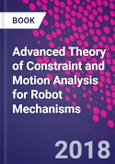Advanced Theory of Constraint and Motion Analysis for Robot Mechanisms provides a complete analytical approach to the invention of new robot mechanisms and the analysis of existing designs based on a unified mathematical description of the kinematic and geometric constraints of mechanisms.
Beginning with a high level introduction to mechanisms and components, the book moves on to present a new analytical theory of terminal constraints for use in the development of new spatial mechanisms and structures. It clearly describes the application of screw theory to kinematic problems and provides tools that students, engineers and researchers can use for investigation of critical factors such as workspace, dexterity and singularity.
Table of Contents
Chapter 1: Introduction (Mechanisms and Components)Chapter 2: Primary Theory of Reciprocal Screws
Chapter 3: Twists and Wrenches of a Kinematic Chain
Chapter 4: Free Motion of the End-Effector of a Robotic Mechanism
Chapter 5: Workspace of the End-Effector of a Robotic Mechanism
Chapter 6: Singularity Analysis of the End-Effector of a Mechanism within Its Workspace
Chapter 7: Kinematics with Four Point Cartesian Coordinates for Spatial Parallel Manipulator
Chapter 8: Kinematics and Statics of Robot Mechanisms
Chapter 9: The Motion Characteristics of a Robot Mechanism within its Workspace
Chapter 10: Fundamental Factors to Investigating the Motions and Actuations of a Mechanism
Chapter 11: The Mechanism Theory and Application of Deployable Structures Based on SLE
Chapter 12: Structure Synthesis of Spatial Mechanisms
Chapter 13: Workspace Synthesis of Spatial Mechanisms
Chapter 14: Kinematic Synthesis of Spatial Mechanisms








